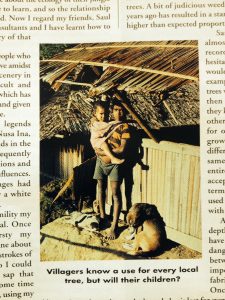Kanikeh village, in the Highlands of Seram, Maluku, Indonesia is in the heart of sago country. There is no farming but people obtain their main nourishment from the starchy pith of wild sago palms (Metoxylon sagu). This means three days work, travelling to and from the palm groves and harvesting the palm starch, can feed a family for a month. This leaves lots of time for hunting, gardening, gathering wild food and leisure. Life in Kanikeh is pretty laid-back.
Every morning, while the women cook breakfast on open fires, the men stand around warming themselves in the sun after the chilly night. Many men and boys have infants tied to their bodies and appear entirely unselfconscious about this arrangement.
I had left my two young children at home with their mother, I was missing them all and this open display of paternal affection touched my heart strings. But it was only when I got home, to the reality of a toy-cluttered suburban house with two children under four, that I realised during the weeks I had spent in the Highlands of Seram I could not recall hearing an infant cry or a child moan once.
 Kanikeh children from an article in Between the Leaves. The walls and thatch are sago palm.
Kanikeh children from an article in Between the Leaves. The walls and thatch are sago palm.
Could it be that children in this indigenous mountain community could be happier than those enjoying all the benefits of western society? Jay Griffiths, author of Wild and Kith, certainly believes we can help our children live happier lives by understanding how children grow up in traditional culture from New Guinea to the Arctic. As part of the no strangers series at the Botanics Jay Griffths will be giving a talk on Kith – the riddle of the childscape on Thursday 11 Sept at 7.00pm http://www.rbge.org.uk/whats-on/event-details/3603
